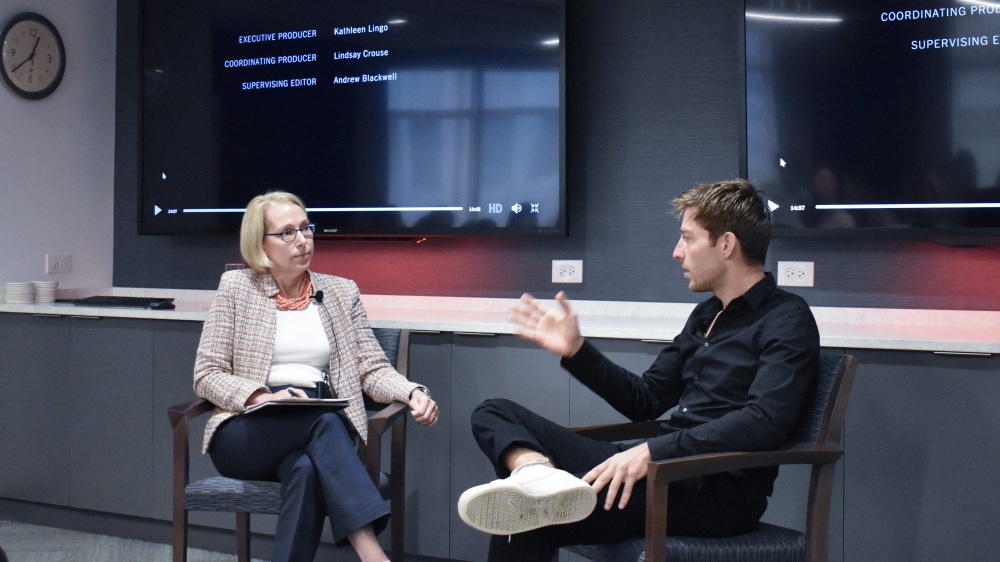
Tabitha Sanders
Communications Associate
Atomic Pulse
The
first thing you notice is the silence. Then, the lined faces of the men sitting
before the camera begin to speak in low, hesitant voices. Some avoid eye
contact with the lens.
“I
guess I’m a little perplexed right now,” the first one says softly.
If
the subjects of Morgan Knibbe’s documentary, “The Atomic Soldiers,” seem like wary
participants, it’s because almost all of them are sharing their stories for the
first time.
They
are America’s atomic veterans—the soldiers who were ordered to participate in more
than 200 above-ground nuclear tests conducted between 1945 and 1962, mostly in
the deserts of Nevada and the Marshall Islands. Unlike the scientists who
monitored the explosions from several miles out of range and were equipped with
safety equipment, these men—and they were all men—were placed within range of the
blast.
They
are hardly well-known. Knibbe only discovered the veterans while scrolling
through unclassified nuclear test videos on YouTube when he began to notice
human-like figures wandering across the screen. Curious, he looked further into
the records and learned that at the dawn of the “Atomic age,” the U.S. had
placed thousands of soldiers within the blast zone of its nuclear weapons
tests.
Theories
vary as to why the men were used. Were they guinea pigs for scientists to
measure the effects of a nuclear blast? Was the military preparing its men in
the case of a nuclear explosion on U.S. soil?
It’s
still not clear. For those who sat before Knibbe’s camera, coming to terms with
what they had witnessed was arduous enough.
Atomic testing
The
era of above-ground testing ended late in 1962, and the following year, the
Limited Test Ban Treaty (LTBT) was signed and took effect. By then, hundreds of
thousands of soldiers had been exposed to the above-ground tests. At the time,
they were told never to share or discuss their experiences with anyone, not
even each other. They were warned that doing so might be considered treason.
One of Knibbe’s subjects admits that he did confide in his wife.
It
wasn’t until the late 1990s that the U.S. government officially recognized the
soldiers’ role in the tests with the
Repeal of Nuclear Radiation and Secrecy Agreements Laws in 1996, giving
veterans the freedom to speak about their involvement. Although the men were suddenly
allowed to talk about what they had witnessed, the message was not efficiently
conveyed. By the time Knibbe started reaching out in the mid-2010s, many were
still worried about government reprisal.
Several weeks ago, Knibbe attended a conference for the National Association
of Atomic Veterans (NAAV), where he encountered more than
one veteran still wary of speaking out.
The veterans
On
Sept. 17, Knibbe screened a 15-minute version of his documentary for an
audience at the Nuclear Threat Initiative and took questions about the film and
the veterans. Audience members were stunned to hear the men describe the moment
of the blasts. Without proper protection, they were told to hold their arms
over their eyes, but the flash of light was so powerful that they were able to
see their bones as if looking through an x-ray.
For
many survivors, speaking out about it may be the only way to begin to understand
and process what they had been through. Some detailed the physical toll of the
radiation exposure – from cancerous tumors to memories of the blast that
continue to disrupt their sleep.
“I
think that a lot of us knew that this was not a good thing for us.” one veteran
tells Knibbe in the film.
The
government has taken some steps to atone. Through the Department of Veterans
Affairs, the U.S. will treat those atomic vets who
participated in “radiation-risk activity” and developed “certain cancers” as a
result. Just this year, the Department
of Defense announced that survivors could
apply for the Atomic Veterans Service Certificate. Although estimates vary by source,
the DoD claims that a whopping 550,000 veterans might have been eligible; just
80,000 may still be alive.
A
wider audience?
So,
what’s next for Morgan Knibbe? A screenplay based on The Atomic Soldiers is in its early stages. He teased the project at
NTI, where he conveyed his hope that a more traditionally cinematic approach
might give the veterans a wider audience.
Until
then, the full version of The Atomic
Soldiers can be found on The Atlantic while a 15-minute
cut of the documentary is available on The New York Times.
Morgan
Knibbe is a documentary filmmaker based in Amsterdam.
Sign up for our newsletter to get the latest on nuclear and biological threats.
"Visiting Hiroshima imparted to me a deep sense of responsibility as well as a renewed energy to work towards a world without nuclear weapons," writes Program Officer Ananya Agustin Malhotra.
Command and Control to air on PBS in early 2017
There is no noise at first, only a flash so bright that the soldiers see their own bones and blood vessels through their skin, as if they have x-ray vision.



